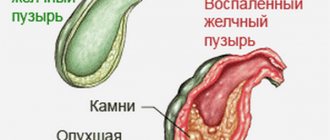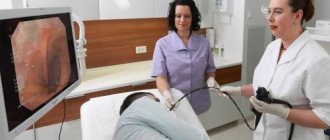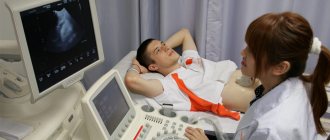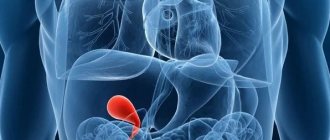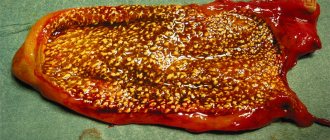Antibiotics for cholecystitis are an important part of the complex treatment of gallbladder inflammation. Symptomatically, cholecystitis is manifested by abdominal pain, nausea, vomiting, and fever. To stop the infection, antibacterial drugs are prescribed.
In addition to antibiotic treatment and symptomatic therapy (for example, biliary medications), it is recommended to adhere to a liquid low-fat diet. In this article we will look at the symptoms and treatment and antibiotics during cholecystitis.
Differential diagnosis
Cholecystitis is most often a consequence of advanced cholelithiasis (GSD) and requires antibiotic therapy to prevent complications in the biliary tract. Thus, 20% of patients with biliary colic who neglect treatment develop an acute form of the inflammatory disease.
If the acute form is not treated, cholecystitis gradually becomes chronic and is complicated by inflammation of neighboring organs: cholangitis, pancreatitis, cholangiohepatitis and others.
More than 90% of cases of cholecystitis are the result of blockage by a gallstone.
To confirm the diagnosis, ultrasound examination of the abdominal organs is used; additional laboratory tests may be prescribed.
Risk factors include:
- oral contraception,
- pregnancy,
- genetic predisposition,
- obesity,
- diabetes and other metabolic disorders,
- liver diseases.
Without timely treatment, cholecystitis becomes chronic. Treatment of cholecystitis is always complex and depends on the severity of the condition and the presence of complications. Most often, treatment is carried out on an outpatient basis at home, but in some cases a hospital stay and even surgical treatment may be required.
Antibiotics are used to combat the infection directly. Only a doctor can select an effective drug based on the clinical picture and laboratory data.
Is it possible to do without antibiotics during cholecystitis?
Cholecystitis occurs when the wall of the gallbladder becomes infected. This is why antibiotics are prescribed to fight infection in adults and children. Despite the fact that antibiotics for inflammation of the gallbladder by themselves are not able to cure cholecystitis, it is impossible to completely avoid their use.
No folk methods can suppress the source of infection in the gallbladder; the maximum is to stimulate the outflow of bile, but not treat the infection.
Moreover, without antibiotics, there is a risk that the infection will spread to neighboring organs - it will enter the bile ducts, liver, and pancreas. Inflammation can progress to the point where doctors have to remove the gallbladder.
Antibacterial therapy is prescribed during the period of exacerbation of cholelithiasis, treatment of calculous, acute and chronic forms of cholecystitis. Broad-spectrum drugs are used to suppress the infection as much as possible and prevent complications.
Why take antibiotics for gallbladder inflammation?
Acute cholecystitis develops due to sudden blockage of the bile duct. A stone that has moved out of place often acts as a “plug”. Bile, having no outlet, creates a focus of stagnation, in which the rapid proliferation of pathogenic microorganisms begins. Staphylococci, streptococci, and E. coli are considered opportunistic microflora that constantly live in the human body in small quantities. When favorable conditions arise, their number rapidly increases, and an inflammatory process develops.
Chronic cholecystitis may be the result of cholelithiasis or the presence of neoplasms. The disease develops slowly, the outflow of bile is not stopped, but is slowed down, which also creates conditions favorable for the active proliferation of bacteria. In this case, the process is sluggish, with vague symptoms.
Any inflammation of the gallbladder is accompanied by the presence of pathogenic flora. Removing blockage of the efferent duct and normalizing the outflow of bile only partially contributes to recovery. The second stage is the fight against infectious agents, and for this purpose antibiotics are prescribed (with a proven bacterial etiology).
Contraindications for antibacterial therapy
All contraindications for the use of antibiotics during cholecystitis and gallstone disease are relative, which means that if the patient has contraindications, the doctor must select the most appropriate alternative treatment option.
Revision of appointments is required in the following cases:
- a history of allergies to antibiotics of any group,
- Infectious mononucleosis,
- pregnancy at all stages,
- lactation period,
- a history of allergic reaction to any medications,
- severe decompensated condition of the patient.
What are the signs to distinguish diseases?
The symptoms and treatment of pancreatitis and cholecystitis have many similarities; only a doctor can make a correct diagnosis.
General symptoms of cholecystitis and pancreatitis:
- Vomiting, nausea.
- Pain syndrome.
- Temperature increase.
- Appearance of sticky sweat.
A person who does not have a medical education will not be able to correctly diagnose himself. Only a narrow specialist - a gastroenterologist - knows the difference between these diseases. The main difference between the ailments is that with pancreatitis the patient has more pain in the left side of the abdomen, and with cholecystitis the pain radiates to the right side, since that is where the gallbladder is located. These diseases may also differ in such characteristic symptoms as dry mouth. It is characteristic of pancreatitis. But bitterness in the mouth is a sign of cholecystitis.
The best antibacterial drug for cholecystitis
Many people are concerned about the question of which antibiotics are best to choose. There is no one “magic” pill to treat cholecystitis.
Each drug has its own spectrum of action and features of its use, therefore the doctor must select an antibiotic for treatment based on the symptoms and the examination performed.
There are standard protocols for the treatment of cholecystitis that guide the choice of drugs. You can find out more about this below in the article.
Inflammation of the gallbladder is a serious disease, and self-medication of cholecystitis is not only unacceptable, but even dangerous. To clarify the diagnosis and select a treatment regimen, additional tests may be prescribed: ultrasound, cultural examination of samples (also called culture), general, biochemical blood tests. Treatment of cholecystitis is always complex, but recovery will not occur without antibacterial therapy.
World standard for antibacterial treatment
Most often, cholecystitis is caused by Escherichia coli E. coli and the pathogenic bacteroid B. fragilis, as well as some types of Klebsiella, enterococci, and pseudomonas. Taking into account the peculiarities of the course of these infections, those groups of antibiotics are prescribed that have the maximum antimicrobial effect. Thus, standard treatment regimens for acute cholecystitis and exacerbation of chronic cholecystitis were developed.
The most recommended antibiotics are:
- piperacillin + tazobactam (Aurotaz, Zopercin, Revotaz, Tazar, Tazpen),
- ampicillin + sulbactam (Ampisid, Sulbacin, Unazin),
- amoxcillin + clavulanic acid (Amoxiclav, Augmentin, Flemoklav),
- meropenem (Alvopenem, Aris, Demopenem, Europenem, Mipenem, Merogram, Meronem, Ronem, Expenem),
- imepenem + cylastin (Prepenem).
Another effective treatment regimen includes a combination of third-generation cephalosporins with metronidazole (Trichopol), which can enhance the effect of treatment. The most commonly used cephalosporins are:
- cefotaxime (Cefantral, Loraxime),
- ceftriaxone (Auroxone, Belcef, Loraxone, Cefogram),
- ceftazidime (Aurocef, Orzid, Fortum, Ceftadim),
- cefoperazone + sulbactam (Macrocef, Sulperazone, Sulcef),
- cefixime (Loprax, Sorcef, Suprax, Cefix).
The listed antibiotics and the trade names under which they are produced are not the only ones. In some cases, the doctor may prescribe other regimens based on test results.
The second choice drugs are gentamicin, chloramphenicol, tetracyclines, erythromycin, and some other types of antibiotics.
In some cases, when, in addition to cholecystitis, the bile ducts are inflamed (cholangitis) or there are other complications, several antibacterial drugs can be used simultaneously. For example, combinations of penicillins with fluoroquinolones - most often ampicillin with ciprofloxacin. Or ampicillin with oxacillin (Ampiox).
Dosages of drugs depend on the severity of the infection and are selected individually. In severe cases, injections of antibacterial drugs are recommended; in milder cases, oral forms can be taken.
Remedies for violation of the secretory function of the pancreas
Preparations containing enzymes of animal origin are prescribed when their production by the pancreas is insufficient in pancreatitis. They lighten the load on the inflamed organ, eliminate heaviness and nausea after eating, and replenish the deficiency of their own enzymes.
Medications for cholecystopancreatitis are prescribed:
- Creon;
- Festal;
- Panzinorm;
- Pancreatin;
- Digestal;
- Pancitrate;
- Mezim.
Omeprazole capsules
In case of pancreatic hypersecretion, when too many enzymes are released, it is advisable to use proton pump inhibitors (Omeprazole, Pantoprazole, Lansoprazole).
Antisecretory drugs:
- eliminate pain syndrome;
- reduce the production of gastric and pancreatic juice;
- reduce tissue swelling;
- reduce pressure in the ducts;
- maintain an alkaline environment in the duodenum, improving digestion.
Treatment of cholecystitis during pregnancy and lactation
To treat cholecystitis in pregnant women, those groups of antibiotics are used that are approved for use during pregnancy. These include some penicillins, cephalosporins, and in some cases macrolides are used. The most commonly used are ampicillin + sulbactam (Ampisid, Sulbacin, Unazine), ceftriaxone (Auroxone, Belcef, Loraxone, Cefogram), azithromycin (Sumamed, Hemomycin).
The listed antibiotics are relatively safe for the fetus and are approved for use during pregnancy if the expected benefit outweighs the possible harm from their use.
But breastfeeding will have to be stopped during treatment so that the child does not receive a portion of the antibiotic along with the milk. It is very difficult to predict the consequences, so it is worth stopping breastfeeding while the mother takes antibacterial drugs.
Under no circumstances should you self-medicate by taking any medications without consulting a doctor. Some antibiotics can cause irreparable harm to the fetus, so treatment during pregnancy and lactation can only be prescribed by a doctor.
Main groups of used antimicrobial agents
Several groups of drugs are used to treat cholecystitis. Each of which has a different effect on the pathogen.
Cephalosporins
Injectable antibiotics are used to treat acute forms of the disease and quickly relieve symptoms. Frequently prescribed representatives: Cefotaxime, Ceftriaxone, Cefazolin. The cephalosporin group affects most pathogenic microbes, but produces many side effects.
Fluoroquinols
They are active against gram-positive and gram-negative flora, but not all representatives are able to penetrate bile. For the treatment of cholecystitis, Ofloxacin and Nolitsin are prescribed. They give good results, and resistance to them is not developed. Fluoroquinols undergo rapid metabolism and therefore require three doses.
Macrolides
They have a wide range of applications and are active against both types of bacterial flora. They have low side effects. They are used for cholecystitis, as a backup option, when microorganisms are resistant to most antibacterial drugs.
Penicillins
These are antibiotics that are actively used to treat the chronic form, as they have an effect when they accumulate sufficiently in the body. Representatives of the group: Amoxicillin, Ampiox, drugs do not act on gram-negative flora, so a sensitivity test must be carried out before treatment. Of all the antibacterial agents, this group has the least toxic effect on the body.
Features of administration and complications of antibacterial therapy
During treatment, you should completely abstain from alcohol, following a diet for cholecystitis: avoiding fatty foods, excess sugar consumption, legumes, sour fruits and berries, canned food, smoked foods, spicy foods, and strong coffee.
It is important to fully adhere to the treatment regimen, do not change the dosage, do not miss a dose, or interrupt the course, even if complete recovery has occurred. Otherwise, the infection may develop resistance to the antibiotic and a rapid relapse of the disease. Like any other drugs, antibiotics have a number of side effects. More details about possible side effects are described in the instructions for the drug.
In user reviews you can find a variety of side effects, but the most common are:
- dysbacteriosis, which leads to disturbances in the gastrointestinal tract,
- vitamin K deficiency, which can cause nosebleeds,
- candidiasis of the oral cavity and other mucous membranes (for example, thrush),
- allergic reactions if there is individual sensitivity to the components of the drug (these signs cannot be ignored).
To prevent side effects, you must strictly follow the instructions and recommendations of your doctor. After long-term use, it is recommended to take a course of probiotics to restore healthy intestinal microflora.
"Ampicillin"
This antibiotic for inflammation of the gallbladder belongs to the category of semisynthetic aminopenicillins. The medicine is highly effective for cholecystitis caused by Escherichia coli, Proteus, Enterococcus, Streptococcus and Staphylococcus.
This is confirmed by the instructions for the antibiotic for inflammation of the gallbladder.
In children over 6 years of age, the drug is prescribed at 100 mg/kg per day. The daily dosage is also divided into 4-6 injections. For patients with renal dysfunction, the dose is adjusted taking into account the glomerular filtration rate. This antibiotic is contraindicated in patients with mononucleosis, severe kidney and liver diseases, lymphoproliferative pathologies, and beta-lactam intolerance.
Your doctor will tell you what antibiotics to take for gallbladder inflammation.


